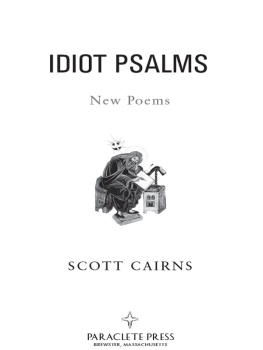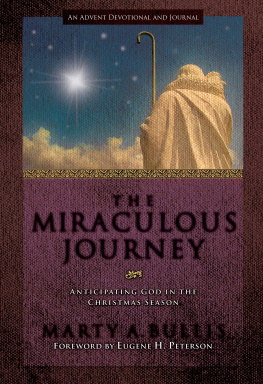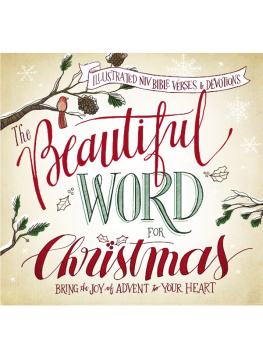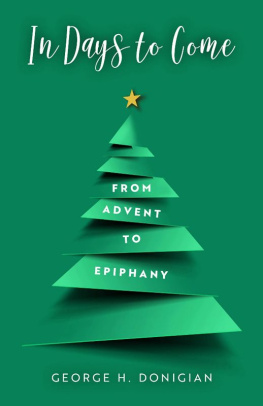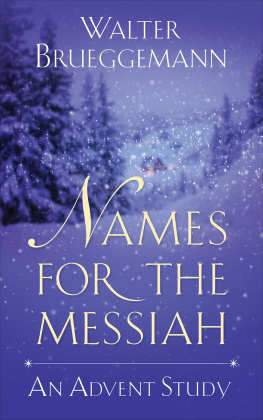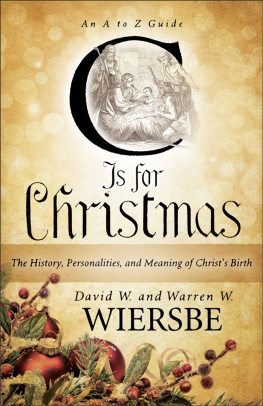
GOD
WITH US

GOD
WITH US
Rediscovering the Meaning of Christmas
BETH BEVIS
SCOTT CAIRNS
EMILIE GRIFFIN
RICHARD JOHN NEUHAUS
KATHLEEN NORRIS
EUGENE PETERSON
LUCI SHAW
EDITED BY GREG PENNOYER & GREGORY WOLFE

PARACLETE PRESS
BREWSTER, MASSACHUSETTS
God with Us: Rediscovering the Meaning of Christmas - Readers Edition
2015 First Printing this Edition
Copyright 2007 by Greg Pennoyer
ISBN: 978-1-61261-707-7
Scripture quotations designated NRSV are taken from the New Revised Standard Version of the Bible, copyright 1989, Division of Christian Education of the National Council of the Churches of Christ in the United States of America. Used by permission. All rights reserved.
Scripture quotations designated RSV are taken from the Revised Standard Version of the Bible, copyright 1952 [2nd edition, 1971] by the Division of Christian Education of the National Council of the Churches of Christ in the United States of America. Used by permission. All rights reserved.
Scripture quotations designated NJB are taken from The New Jerusalem Bible, copyright 1985 by Darton, Longman & Todd, Ltd. and Doubleday, a division of Bantam Doubleday Dell Publishing Group, Inc. Reprinted by permission.
Scripture quotations designated REB are from the Revised English Bible (Oxford, England: Oxford University Press; New York: Cambridge University Press, 1989).
Scripture quotations designated THE MESSAGE are taken from The Message by Eugene H. Peterson, copyright 1993, 1994, 1995, 1996, 2000, 2001, 2002. Used by permission of NavPress Publishing Group. All rights reserved.
Scripture quotations designated (KJV) are taken from the King James Version.
Title page art: Giotto di Bondone. Nativity. Scrovegni Chapel, Padua, Italy. Scala/Art Resource, NY.
The original edition of God with Us was cataloged by the Library of Congress as follows:
Library of Congress Cataloging-in-Publication Data
God with us : rediscovering the meaning of Christmas / Scott Cairns [et al] ; edited by Greg Pennoyer and Gregory Wolfe.
p. cm. ISBN 978-1-55725-541-9
1. AdventMeditations. 2. ChristmasMeditations. 3. EpiphanyMeditations. I. Cairns, Scott. II. Pennoyer, Greg. III. Wolfe, Gregory.
BV40.G58 2007
242.33dc22
2007021985
10 9 8 7 6 5 4 3 2 1
All rights reserved. No portion of this book may be reproduced, stored in an electronic retrieval system, or transmitted in any form or by any meanselectronic, mechanical, photocopy, recording, or any otherexcept for brief quotations in printed reviews, without the prior permission of the publisher.
Published by Paraclete Press
Brewster, Massachusetts
www.paracletepress.com
Printed in the United States of America
Contents
Eugene Peterson
Richard John Neuhaus
Scott Cairns
Luci Shaw
Kathleen Norris
Emilie Griffin
Beth Bevis
Greg Pennoyer
Preface
T HIS BOOK IS THE RESULT OF A JOURNEY that began on Christmas morning, 1998, in Ottawa in a small Anglo-Catholic church called St. Barnabas. It was my first encounter with what my high church friends call smells and bells. Throughout that Christmas service a translucent ribbon of incense lingered just above eye level. Its constant presence provided a gentle introduction to the physical elements of the Christmas service that I had not experienced beforethe Eucharist, the processions, the sights, sounds, and, yes, smells.
It was a mystery to me at the time, but I left the church that Christmas morn with a sense that I had worshipped God with all my senseswith my whole beingfor the first time in my life.
My journey into the heart of the churchs liturgical and spiritual theology continues, but in a strange way it keeps returning me, again and again, to Christmas day. For it is in this great feastin the celebration of the Incarnation, the Word made fleshthat I can begin to see what an embodied faith might mean.
Like most adults, I have a difficult time relating to Christmas. Having lost the wonder of childhood I try to make up for it through our peculiarly modern mixture of materialism and sentimentality. For me, as for so many people (including millions of believers), Christmas has become a parody of itself.
The more I reflected on my experience at St. Barnabas, the more I realized that my own temptation to sentimentalize Christmas involved turning away from the messiness of my disenchanted, adult life. Christmas is, after all, the story of the Creator entering into his creationa creation that has been marred by human sin and weakness. It is the story of a God who does not disdain this world, despite its frailty, ambiguities, and messiness. The God who became a helpless babe in a stable entered into our human anxieties and confusions and redeemed them.
Christmas is the feast of the Incarnation, which is the mystery of God with us in the flesh. When we cut through the sentiment and marketing to the spiritual riches of Christmas, we recover not only a sense of who God is, but also who we are as human beings.
Such a recovery cannot happen in a day. One of the things I have learned about the ancient church is that it knew that real, lasting change comes about over time, which is why it set aside whole seasons for meditation and celebration of the great mysteries of faith. And so the early Christians set Christmas in the larger context of the Advent season that precedes it and the Epiphany season that extends its meaning outward from Bethlehem to the whole world. To live through these seasons is to embark on a pilgrimage through time.
God With Us is intended as a companion and guide for those who would make this journey. Each of the elements of this bookdaily meditations, Scripture selections, prayers, histories of the major feast days, selected classic and contemporary artworkcan help us along the path. Together, they weave together the rich tapestry of Christmas, calling us to an embodied faith, one that finds redemption in the messiness of our lives and encounters the divine in the ordinary stuff of this world.
God with us. This is the meaning of the Incarnation. This is the meaning of Christmas.
GREG PENNOYER
Eugene Peterson
Introduction
B IRTH: WONDER ASTONISHMENT adoration. There cant be very many of us for whom the sheer fact of existence hasnt rocked us back on our heels. We take off our sandals before the burning bush. We catch our breath at the sight of a plummeting hawk. Thank you, God. We find ourselves in a lavish existence in which we feel a deep sense of kinshipwe belong here; we say thanks with our lives to Life. And not just Thanks or Thank It but Thank You. Most of the people who have lived on this planet earth have identified this You with God or gods. This is not just a matter of learning our manners, the way children are taught to say thank you as a social grace. It is the cultivation of adequateness within ourselves to the nature of reality, developing the capacity to sustain an adequate response to the overwhelming gift and goodness of life.
Wonder is the only adequate launching pad for exploring this fullness, this wholeness, of human life. Once a year, each Christmas, for a few days at least, we and millions of our neighbors turn aside from our preoccupations with life reduced to biology or economics or psychology and join together in a community of wonder. The wonder keeps us open-eyed, expectant, alive to life that is always more than we can account for, that always exceeds our calculations, that is always beyond anything we can make.
Next page


